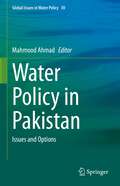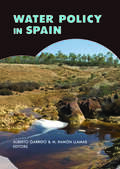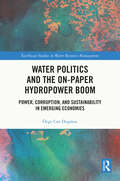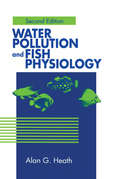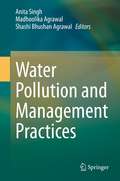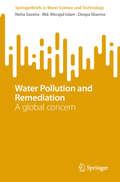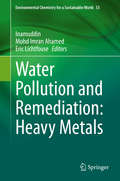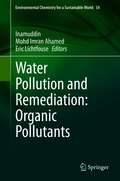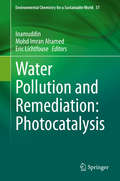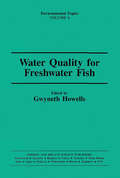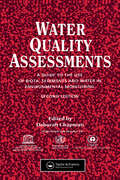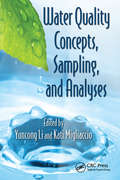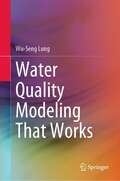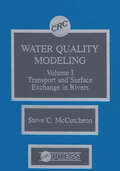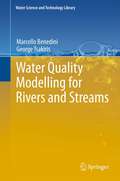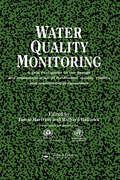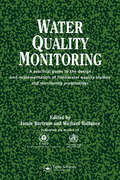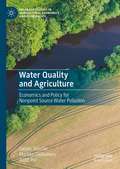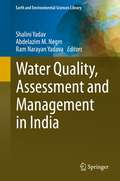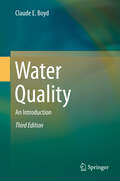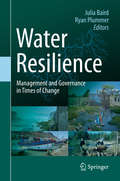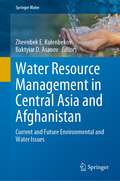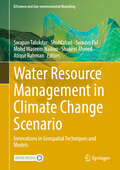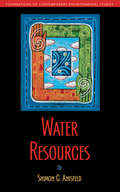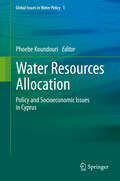- Table View
- List View
Water Policy in Pakistan: Issues and Options (Global Issues in Water Policy #30)
by Mahmood AhmadThe water policy issues are well- documented in a large set of reports and studies, completed over time showing that the policy prescription and its implementation has been weak in the past as this book reveals. The key reforms initiated were lost due to a lack of government’s will and commitment and more so by pervasive political economy of water. Given this background, each chapter in the book follows a balanced approach in seeking and evaluating alternate solutions to water management issues, especially improvements in water governance and tackling new challenges emerging from the climate change in the short and long term. This approach underpins the importance of moving from the culture of piloting projects to actual implementation on an impact-oriented scale. The book would also highlight that most of the water solutions lie outside the water sector such as agriculture, population, economy, etc. Post COVID-19 policies are exploring new food-health nexus that calls for nature based solutions for our future agriculture growth. The book would show case pioneer work underway in Pakistan on how new policy discourse can reduce water use in agriculture without investing in expensive water technology and infrastructure, thus saving enough water for other competing purposes.
Water Policy in Spain
by Alberto Garrido M. Ramón LlamasThough the modern Spanish State was formed in the mid Fifteenth Century, historical records show that water works, statues, and the utilization of water dates back to centuries BC. As a semi-arid country, the effort to control, store and assure water supplies to cities and fields is present in numerous historical and political landmarks.Water polic
Water Politics and the On-Paper Hydropower Boom: Power, Corruption, and Sustainability in Emerging Economies (Earthscan Studies in Water Resource Management)
by Özge Can DogmusThis book examines how the on-paper hydropower boom impacts the safe and fair access to water and energy in emerging economies.The global hydropower boom is largely made up of small hydropower plants located in emerging economies, but a lack of funding, over-ambitious planning, and corruption have halted the production of these projects. Describing this state as the ‘on-paper’ hydropower boom, this book shifts attention to the hydrosocial problems arising from hydropower projects that remain on paper. It examines how these proposed but unbuilt projects can lead to disruptions in the control and governance of water resources and increase the international dependence of emerging countries due to deep problems in their sustainable development planning and how all this can affect both ecosystems and the communities that depend on them. In doing so, it critically examines the dominant discourses on energy security and sustainable development, emphasises the extent to which the effects of global imperialism are at play, and examines the effects of international power relations in the hydrosocial context and their implications for perpetuating international relations of dependency. Further, this book provides a unique perspective on the global hydropower boom by highlighting that although the global hydropower boom largely remains on paper, it can still have a significant impact on human–water systems. Contributing to the debate on hydrosocial relationships, each chapter offers an insightful examination of the social, cultural, and political interactions that humans have with water and uses these insights to provide a nuanced understanding of the challenges and issues associated with on-paper plans.This book will be of great interest to students and scholars of water politics, water governance, political ecology, corruption and environmental economics, as well as sustainable development policymakers.
Water Pollution and Fish Physiology
by Alan G. HeathThis book provides a concise synthesis of how toxic chemical pollutants affect physiological processes in teleost fish. This Second Edition of the well-received Water Pollution and Fish Physiology has been completely updated, and chapters have been added on immunology and acid toxicity. The emphasis, as in the first edition, is on understanding mechanisms of sublethal effects on fish and their responses to these environmental stressors. The first chapter covers the basic principles involved in understanding how fish respond, in general, to environmental alterations. Each subsequent chapter is devoted to a particular organ system or physiological function and begins with a short overview of normal physiology of that system/function. This is followed by a review of how various toxic chemicals may alter normal conditions in fish. Chapters covering environmental hypoxia, behavior, cellular enzymes, and acid toxicity are also included. The book closes with a discussion on the practical application of physiological and biochemical measurements of fish in water pollution control in research and regulatory settings.
Water Pollution and Management Practices
by Anita Singh Madhoolika Agrawal Shashi Bhushan AgrawalWater pollution is a matter of concern for both developing and developed parts of the world. This book presents an overview on water pollution and its sustainable management. The book discusses the fundamental aspects of water pollution as well as advanced sustainable technologies for abating water pollution. It is a comprehensive collection of information related with water pollutants which are extremely harmful to man, other living organisms and to the ecosystems. It is all-inclusive coverage of technical, socio-political, scientific as well as social issues revolving around water pollution and management. The book brings out innovative ideas promoting sustainable technologies and extensively covers the diversity of modern technologies related to prevention of water pollution. Book also covers social aspects of water related issues. It is an essential reading for upper level graduates and undergraduates pursuing environmental studies and researchers in the field of waste water management
Water Pollution and Remediation: A global concern (SpringerBriefs in Water Science and Technology)
by Neha Saxena Deepa Sharma Md. Merajul IslamToday, there is much discussion about the dangers of water contamination to human health. Numerous environmental studies and projects are undertaken and accomplished every year. Despite this, most developing countries continue to struggle with the inefficient administration of their water supplies. The problem of contaminated water and the method of purifying it are both extremely challenging, and much of the research done on the topic is probably not up to the mark to cope with the current environmental issues. Henceforth, appropriate methods need to be developed and established to improve water quality. Through this book, the authors aim to provide a framework for understanding the causes, pollutants, and potential remediation for water contamination. The text provides up-to-date reviews of the latest research and practises for removing contaminants from water through green methods.
Water Pollution and Remediation: Heavy Metals (Environmental Chemistry for a Sustainable World #53)
by Eric Lichtfouse Inamuddin Mohd Imran AhamedPollution of waters by toxic metals is accelerating worldwide due to industrial and population growth, notably in countries having poor environmental laws, resulting in many diseases such as cancer. Classical remediation techniques are limited. This books reviews new, advanced or improved techniques for metal removal, such as hybrid treatments, nanotechnologies and unconventional adsorbents, e.g. metal-organic frameworks. Contaminants include rare earth elements, arsenic, lead, cadmium, chromium, copper and effluents from the electronic, textile, agricultural and pharmaceutical industries.
Water Pollution and Remediation: Organic Pollutants (Environmental Chemistry for a Sustainable World #54)
by Eric Lichtfouse Inamuddin Mohd Imran AhamedWastewater pollution is a major issue in the context of the future circular economy because all matter should be ultimately reused, calling for efficient depollution techniques. This book present timely reviews on the treatment of wastewater contaminated by organic pollutants, with focus on aerobic granulation and degradation. Organic pollutants include microplastics, phthalates, humic acids, polycyclic aromatic hydrocarbons, pharmaceutical drugs and metabolites, plastics, oil spills, petroleum hydrocarbons, personal care products, tannery waste, dyes and pigments.
Water Pollution and Remediation: Photocatalysis (Environmental Chemistry for a Sustainable World #57)
by Eric Lichtfouse Inamuddin Mohd Imran AhamedIn the context of climate change and fossil fuel pollution, solar energy appears as a cheap and sustainable fuel for many environmental applications, yet the efficiency of techniques has to be improved. This book reviews recent methods and applications of photocatalysis for the treatment of wastewater containing bacteria, heavy metals, organic pollutants, dyes and tannery effluents. Basics of water pollution, polluted river ecosystems and membranes are also detailed.
Water Qual Freshwater Fish
by Gwyneth HowellsThis book covers the major polluting chemicals affecting fisheries in European fresh waters and the effort required to extend the work towards the preparation of critical reviews on less important chemicals would be out of proportion to the benefits obtained.
Water Quality Assessments: A guide to the use of biota, sediments and water in environmental monitoring, Second Edition
by Deborah ChapmanThis guidebook, now thoroughly updated and revised in its second edition, gives comprehensive advice on the designing and setting up of monitoring programmes for the purpose of providing valid data for water quality assessments in all types of freshwater bodies. It is clearly and concisely written in order to provide the essential information for all agencies and individuals responsible for the water quality.
Water Quality Concepts, Sampling, and Analyses
by Yuncong Li Kati MigliaccioAs water quality becomes a leading concern for people and ecosystems worldwide, it must be properly assessed in order to protect water resources for current and future generations. Water Quality Concepts, Sampling, and Analyses supplies practical information for planning, conducting, or evaluating water quality monitoring programs. It presents the
Water Quality Modeling That Works
by Wu-Seng LungThis book offers a practical guidance for environmental engineers and scientists charged with assessing the cause-and-effect of pollutants in receiving water systems. Instead of blindly running models, which is a practice seen too often in today’s field that can result in results with uncertainty, modelers must first understand the physical insights of the specific water systems in order to properly calibrate the parameters of the models. This book reinforces the critical importance of properly understanding the physical attributes of water systems by drawing on the author’s extensive experience in modeling with strong data support. This is also what sets this book apart from the volumes currently available in the water quality modeling field – nearly all other books in the field are categorized as textbooks, and unlike this book, offer few practical examples or exercises to follow. Environmental engineers and scientists engaged in quantifying the water quality impacts of pollutants to specific water systems will find this book valuable in their day-to-day practices. This book is a necessary volume for water quality engineers and scientists to consult for the regulatory planning and management of water systems
Water Quality Modeling: River Transport and Surface Exchange, Volume I
by Steven C. McCutcheonThis fascinating work is divided into two main sections. Part I reviews the basic principles of water movement in channels and the mass balance approach common to most models. It also covers the practical usefulness, model peer review, and guidance on model selection and calibration. Part II discusses flow simulation and prediction of time of travel, dye tracing and mixing, heat balance and temperature modeling, and reaeration and volatilization. This interesting, easy-to-read volume includes comprehensive reviews for the use of fluorescent water tracing dyes, longitudinal dispersion, evaporation and wind speed functions, prediction of saturation concentrations of dissolved oxygen, and reaeration coefficients. This book furnishes the reader with appendices which provide a synopsis of available computer models and gives a comprehensive listing of methods used to measure flow rates in rivers, tributaries, and pipes and channels introducing wastewaters into streams. This volume is a valuable, indispensable reference for all researchers, instructors, students in advanced environmental modeling courses, and practicing engineers.
Water Quality Modelling for Rivers and Streams
by George Tsakiris Marcello BenediniThe main objective of the Water Framework Directive in the European countries is to achieve a "good status" of all the water bodies, in the integrated management of river basins. In order to assess the impact of improvement measures, water quality models are necessary. During the previous decades the progress in computer technology and computational methods has supported the development of advanced mathematical models for pollutant transport in rivers and streams. This book is intended to provide the fundamental knowledge needed for a deeper understanding of these models and the development of new ones, which will fulfil future quality requirements in water resources management. This book focuses on the fundamentals of computational techniques required in water quality modelling. Advection, dispersion and concentrated sources or sinks of contaminants lead to the formulation of the fundamental differential equation of pollutant transport. Its integration, according to appropriate initial and boundary conditions and with the knowledge of the velocity field, allows for pollutant behaviour to be assessed in the entire water body. An analytical integration is convenient only in one-dimensional approach with considerable simplification. Integration in the numerical field is useful for taking into account particular aspects of water body and pollutants. To ensure their reliability, the models require accurate calibration and validation, based on proper data, taken from direct measurements. In addition, sensitivity and uncertainty analysis are also of utmost importance. All the above items are discussed in detail in the 21 chapters of the book, which is written in a didactic form for professionals and students.
Water Quality Monitoring: A Practical Guide to the Design and Implementation of Freshwater Quality Studies and Monitoring Programmes
by Jamie Bartram Richard BallanceWater quality monitoring is a fundamental tool in the management of freshwater resources, and this book covers the entire monitoring process providing detailed guidance for implementing a monitoring network with step-by-step descriptions of field and laboratory methods.
Water Quality Monitoring: A practical guide to the design and implementation of freshwater quality studies and monitoring programmes
by Jamie Bartram Richard BallanceWater quality monitoring is an essential tool in the management of water resources and this book comprehensively covers the entire monitoring operation.This important text is the outcome of a collborative programme of activity between UNEP and WHO with inputs from WMO and UNESCO and draws on the international standards of the International Organization of Standardization.
Water Quality and Agriculture: Economics and Policy for Nonpoint Source Water Pollution (Palgrave Studies in Agricultural Economics and Food Policy)
by Markku Ollikainen James Shortle Antti IhoWater pollution control has been a top environmental policy priority of the world’s most developed countries for decades, and the focus of significant regulation and public and private spending. Yet, significant water quality problems remain, and trends for some pollutants are in the wrong direction. This book addresses the economics of water pollution control and water pollution control policy in agriculture, with an aim towards providing students, environmental policy analysts, and other environmental professionals with economic concepts and tools essential to understanding the problem and crafting solutions that can be effective and efficient. The book will also examine existing policies and proposed reforms in the developed world. Although this book addresses and has a general applicability to major water pollutants from agriculture (e.g., pesticides, pharmaceuticals, sediments, nutrients), it will focus on the sediment and nutrient pollution problem. The economic and scientific foundations for pollution management are best developed for these pollutants, and they are currently the top priorities of policy makers. Accordingly, the authors provide both highly salient and informative cases for developing concepts and methods of general applicability, with high profile examples such as the Chesapeake Bay, Lake Erie, and the Gulf of Mexico Dead Zone in the US; the Baltic Sea in Northern Europe; and Lake Taupo in New Zealand.
Water Quality, Assessment and Management in India (Earth and Environmental Sciences Library)
by Abdelazim M. Negm Shalini Yadav Ram Narayan YadavaThis book presents up-to-date information on the status of water resources in India. It presents an assessment of the surface water and groundwater condition to help stakeholders take the necessary actions to control pollution and make the country’s water resources sustainable. The book addresses various topics, including forest-water interactions for governing water quality at catchment scales, water quality status, rainwater harvesting methods, acid-mine drainage, water pollution, management strategies, drinking water quality, and treatment of industrial wastewater. Given its scope, the book offers a valuable tool for policy planners who wish to improve the current situation and move toward sustainable water resources in India.
Water Quality: An Introduction (Aquaculture Ser.)
by Claude E. BoydThis volume is of great importance to humans and other living organisms. The study of water quality draws information from a variety of disciplines including chemistry, biology, mathematics, physics, engineering, and resource management.University training in water quality is often limited to specialized courses in engineering, ecology, and fisheries curricula. This book also offers a basic understanding of water quality to professionals who are not formally trained in the subject.The revised third edition updates and expands the discussion, and incorporates additional figures and illustrative problems. Improvements include a new chapter on basic chemistry, a more comprehensive chapter on hydrology, and an updated chapter on regulations and standards.Because it employs only first-year college-level chemistry and very basic physics, the book is well-suited as the foundation for a general introductory course in water quality. It is equally useful as a guide for self-study and an in-depth resource for general readers.
Water Resilience: Management and Governance in Times of Change
by Ryan Plummer Julia BairdThis book synthesizes current knowledge and understanding of management and governance in the context of water resilience; advances theory through synthesis of research and experiences from a variety of disciplinary perspectives. The book highlights the implications of theory and experience for innovation in practice and policy; and it explores frontiers and future research. The book further addresses the need for a consolidated, interdisciplinary approach to the theoretical advances and practical implications of water resilience for academics, resource managers, aid organizations, policy makers and citizens.
Water Resource Management in Central Asia and Afghanistan: Current and Future Environmental and Water Issues (Springer Water)
by Zheenbek E. Kulenbekov Baktyiar D. AsanovThe book provides a cross-sectoral, multi-scale assessment of development-directed investigations in the main rivers of wider Central Asia and Afghanistan. The book highlights the development of river systems, water reservoirs, ecosystems and risks as well as the impact of climate change on water resources in Central Asian countries and Afghanistan. It provides information on the genesis of river basins, physical and chemical properties of water in rivers, and the hydrological regimes of the rivers of Central Asia and Afghanistan. The book is useful for scientists and researchers whose work focuses on rivers and the use of water resources, irrigation, ecosystems, risks, water supply, climate change and remote sensing, as well as for students and planners, administrations and other stakeholders in the water sector.
Water Resource Management in Climate Change Scenario: Innovations in Geospatial Techniques and Models (GIScience and Geo-environmental Modelling)
by Shakeel Ahmed Atiqur Rahman Swapan Talukdar Shahfahad Swades Pal Mohd Waseem NaikooThis book seeks to showcase the ongoing challenges of water resource and its management through innovative and cutting-edge approaches (flooding and droughts and their respective impacts; spatial and urban planning; early warning systems; estimation of losses; water resource in the age of global climate change; risk communication; meteorology; integrated analysis; risk mitigation; infrastructures; nature-based management; watershed management; transport; legal assessment; vulnerability analysis; public participation; or case studies). In the face of current global changes, the availability and quality of water resources are under severe threat. Indeed, in all sectors related to water resource management, sustainable development is important for present and future generations. Indeed, multiple problems such as water shortage or flooding, as well as environmental pollution phenomena, are observed. This situation is further exacerbated by poor management practices and unsustainable extraction of water for various consumptive uses. Consequently, many regions around the world, particularly urban areas, are becoming water stressed and conflicts over access to water are becoming ever more common. To overcome the significant challenges fundamental to the management of water resources, cutting-edge knowledge, innovative approaches, and an in-depth understanding of the inherent scientific, economic, social, and environmental issues are imperative. Therefore, water resource management requires a clear understanding of the ongoing challenges and innovative approaches. The authors and editors believe that this book provides huge knowledge and data in the fields of water resource management, earth environmental sciences, humanities, and social sciences, which target a diverse range of readers, such as academics, scientists, students, environmentalists, meteorologists, urban planners, remote sensing, and GIS experts.
Water Resources (Foundations Contemporary Environmental)
by Shimon C. AnisfeldIn this concise introduction to water resources, Shimon Anisfeld explores the fundamental interactions between humans and water, including drinking, sanitation, irrigation, and power production. The book familiarizes students with the current water crisis and with approaches for managing this essential resource more effectively in a time of rapid environmental and social change. Anisfeld addresses both human and ecological problems, including scarcity, pollution, disease, flooding, conflicts over water, and degradation of aquatic ecosystems. In addition to providing the background necessary to understand each of these problems, the book discusses ways to move towards better management and addresses the key current debates in the water policy field. In the past, water development has often proceeded in a single-sector fashion, with each group of users implementing its own plans without coordination with other groups, resulting in both conflict and inefficiency. Now, Anisfeld writes, the challenge of water management is figuring out how to balance all the different demands for water, from sanitation to energy generation to ecosystem protection. For inquiring students of any level, Water Resources provides a comprehensive one-volume guide to a complex but vital field of study.
Water Resources Allocation
by Phoebe KoundouriThe dilemma facing Cyprus--that of limited water supplies (both in terms of quantity and quality) in the face of steadily increasing water demand, coupled with a fragmented institutional structure of the water sector--is characteristic of most arid and semi-arid countries all over the world. Another common characteristic of Cyprus is that the water management administrative boundaries there do not coincide with the hydrological ones, while the ongoing political problem of the island creates significant administration problems.
